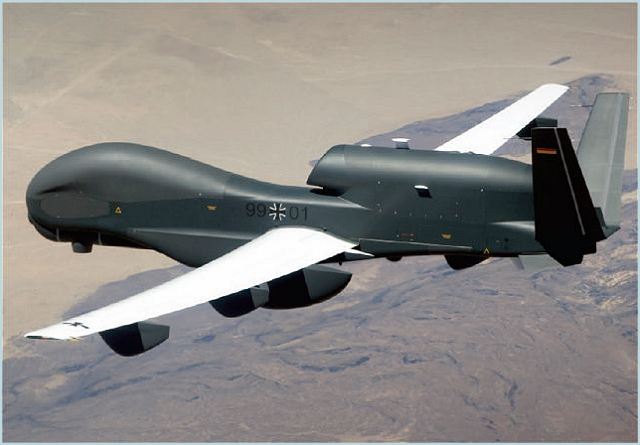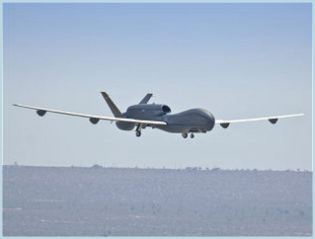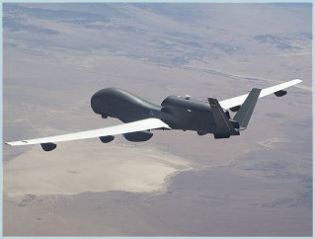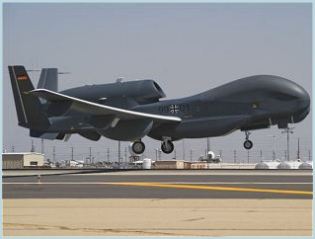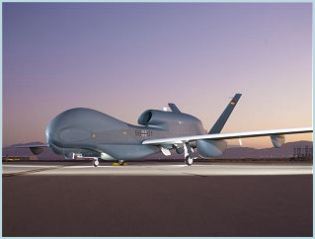Euro Hawk
| a | ||||||||||||||||||||||
|
Euro Hawk UAS Unmanned Aircraft System Drone
|
||||||||||||||||||||||
|
|
||||||||||||||||||||||
|
|
||||||||||||||||||||||
|
EURO HAWK® is an high-altitude, long-endurance (HALE), signals intelligence (SIGINT) unmanned aircraft system based on the RQ-4 Global Hawk produced by Northrop Grumman for the German Bundeswehr. |
||||||||||||||||||||||
| Variants | ||||||||||||||||||||||
|
- RQ-4 Global Hawk: american version
- RQ-4 Block 20 (United States) - RQ-4 Block 40 (United States) |
||||||||||||||||||||||
| Technical Data | ||||||||||||||||||||||
| Design | ||||||||||||||||||||||
|
The wings and tail of the aircraft are of graphite composite construction. The V-configuration of the tail, built by Aurora Flight Sciences, provides a low radar and infrared signature. The wings, constructed by Vought Aircraft Industries, have a span of 7.3 m, with hard points for external pods up to 1,000lb each. Vought and ATK are fabricating an enhanced wing, one of a number of system improvements to enable Global Hawk to carry an increased payload. The aluminium fuselage contains pressurised payload and avionics compartments. Honeywell Aerospace, Torrance, California, supplied the environmental control systems. The landing gear is supplied by Heroux Inc. of Quebec, Canada. The nose gear which is a derivative of the F-5 design is height adjustable to suit the runway characteristics. The landing gear automatically retracts at an altitude of 1,220 m.
|
||||||||||||||||||||||
| Engine | ||||||||||||||||||||||
|
The Rolls-Royce AE3007H turbofan core engine specifically developed for the Global Hawk program is a growth version of the AE3007 engine, currently in use in the Citation X and the Embraer Regional Jet. In the 8,000- pound thrust class, the engine is a high bypass, two spool, axial flow engine, flat rated at 7,580 pounds of thrust, uninstalled, sea level static to 113 degrees Fahrenheit ambient temperature. |
||||||||||||||||||||||
| Accessories | ||||||||||||||||||||||
|
The system combines advanced technology sensors with extensive range and the endurance to remain on station for long periods of time. High-resolution sensors that can look through adverse weather day or night from an altitude of 65,000 ft, can conduct surveillance over an area the size of Austria and Croatia combined, in just 24 hours. These proven capabilities are paving the way for Global Hawk and other UAVs to assume missions suited for autonomous aircraft - augmenting manned aircraft and contributing to national security in ways not imagined a few years ago.
The EURO HAWK® will carry a new SIGINT mission system developed by EADS Deutschland GmbH (Cassidian) and integrated in Manching, Germany. |
||||||||||||||||||||||
| Combat use | ||||||||||||||||||||||
|
Euro Hawk can carry out reconnaissance missions in all types of operations. The 14,000nm range and 42-hour endurance of the air vehicle, combined with satellite and line-of-sight communication links to ground forces, permits worldwide operation of the system. High-resolution sensors, including visible and infrared electro-optical systems and synthetic aperture radar, will conduct surveillance over an area of 40,000nm² to an altitude of 65,000ft in 24 hours.
The Raytheon Intelligence & Information Systems mission control ground station for the Euro Hawk UAS includes a shelter measuring 2.43 m × 2.43 m × 7.3 m housing the communications, command and control, mission planning and image processing computers with four workstations for the mission control staff and officers. The mission control centre has data up- and down-links to the Global Hawk vehicle directly and via the Ku satellite and the UHF satellite systems. The Raytheon launch and recovery ground station is housed in an 2.43 m x 2.43 m x 3 m shelter equipped with two workstations and the launch and recovery mission computers. The launch and recovery station has up- and down- data communications links to the Global Hawk vehicle and to the UHF communications satellite. The complete mission control element (MCE) and the launch and recovery element (LRE) is transportable in a single load on the C-5B transporter aircraft and in less than two loads on the C-17 transporter. |
||||||||||||||||||||||
| Specifications | ||||||||||||||||||||||
|
||||||||||||||||||||||
 |
||||||||||||||||||||||
|
||||||||||||||||||||||



























